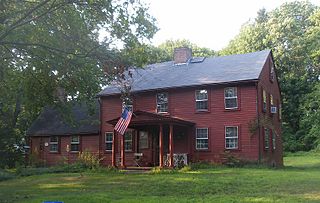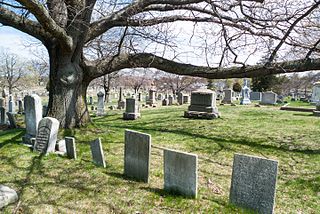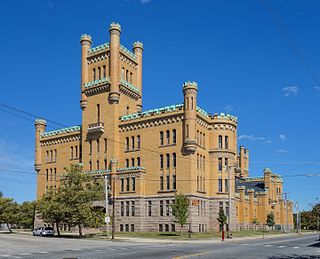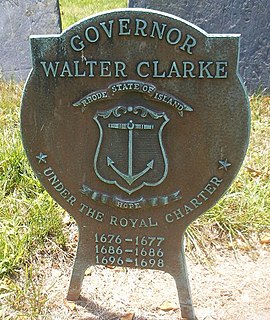
Cranston, once known as Pawtuxet, is a city in Providence County, Rhode Island, United States. The official population of the city is 80,559, making it the second largest in the state. The center of population of Rhode Island is located in Cranston. Cranston is a part of the Providence metropolitan area.

John Brown I was an American merchant, enslaver, and statesman from Providence, Rhode Island. Together with his brothers Nicholas, Joseph and Moses, John was instrumental in founding Brown University and moving it to their family's former land in Providence. John Brown laid the cornerstone of the university's oldest building in 1770, and he served as its treasurer for 21 years. Brown was one of the founders of Providence Bank and became its first president in 1791. He was active in the American Revolution, notably as an instigator of the 1772 Gaspee Affair, and he served in both state and national government. At the same time, he was a powerful defender of enslaving Blacks, clashing aggressively—in newspapers, courts and politics—with his brother Moses, who had become an abolitionist.

Oak Lawn or Oaklawn is a historical village in southwest Cranston, Rhode Island. Prior to being named "Oak Lawn" in 1872 the area was known as "Searle's Corner". The Edward Searle House, built in 1677, and one of the oldest standing structures in Rhode Island, is located in Oak Lawn. The village is known for its annual May Breakfast, a New England tradition that began in Oak Lawn in 1865 as a way for the members of the Oak Lawn Baptist Church to raise money for local American Civil War veterans. The 1855 Herman Melville novel "Israel Potter" is based on the life and adventures of an American Revolutionary soldier who was raised on a farm near present-day Oak Lawn. Oak Lawn is also the site of an important archeological excavation: in the 1950s archeologists discovered bowls and other Native American artifacts, carved from soapstone and dating back more than 10,000 years. In the pre-colonial era the area was populated with bands of the Narragansett Indians known as the "Meshanticut" and "Natick" Indians.

Arthur Fenner was an American politician who served as the fourth Governor of Rhode Island from 1790 until his death in 1805. He has the seventh longest gubernatorial tenure in post-Constitutional U.S. history at 5,641 days. Fenner was a prominent Country Party (Anti-federalist) leader. Around 1764, Fenner joined several others as a petitioner for the chartering of the College in the English Colony of Rhode Island and Providence Plantations.

Wickford is a small village in the town of North Kingstown, Rhode Island, United States, which is named after Wickford in Essex, England. Wickford is located on the west side of Narragansett Bay, just about a 20-minute drive across two bridges from Newport, Rhode Island. The village is built around one of the most well-protected natural harbors on the eastern seaboard, and features one of the largest collections of 18th century dwellings to be found anywhere in the northeast. Today the majority of the village's historic homes and buildings remain largely intact upon their original foundations.

The stone-ender is a unique style of Rhode Island architecture that developed in the 17th century where one wall in a house is made up of a large stone chimney.

The North Burial Ground is a 110-acre (0.45 km2) cemetery in Providence, Rhode Island dating to 1700, the first public cemetery in Providence. It is located north of downtown Providence, bounded by North Main Street, Branch Avenue, the Moshassuck River, and Cemetery Street. Its main entrance is at the junction of Branch and North Main. The burial ground is one of the larger municipal cemeteries in Southern New England, and it accepts 220 to 225 burials per year.
John Cranston (1625–1680) was a colonial physician, military leader, legislator, deputy governor and governor of the Colony of Rhode Island and Providence Plantations during the 17th century.

The Clement Weaver–Daniel Howland House is a historic stone-ender timber frame house built in 1679. This rare example of primitive 17th-century architecture is located at 125 Howland Road in East Greenwich, Rhode Island. It is the oldest documented dwelling house in Kent County and the second oldest home in Rhode Island.

The Joseph Smith House is a historic house at 109 Smithfield Road in North Providence, Rhode Island, United States. It is a 2½-story wood frame house, six bays wide, with a shed-style addition to the rear giving it a saltbox appearance. The oldest portion of this house, built around 1705, is a classical Rhode Island stone-ender house, whose large chimney has since been completely enclosed in the structure. The lower levels of this chimney are believed to predate King Philip's War (1675–76), when the previous house was burned. The 1705 house was built by Joseph Smith, grandson of John Smith, one of Rhode Island's first settlers. It was greatly enlarged in 1762 by Daniel Jenckes, a judge from a prominent Rhode Island family, for his son, and was for many years in the hands of Jenckes' descendants. The house is the only known surviving stone-ender in North Providence.

The Governor William Sprague Mansion is an historic mansion and museum at 1351 Cranston Street in Cranston, Rhode Island. The house was the birthplace of Governor William Sprague III and his nephew, Governor William Sprague IV.

The Edward Searle House is an historic stone ender in Cranston, Rhode Island in the village of Oaklawn. The house is one of the oldest surviving buildings in the state.

The Broadway–Armory Historic District is a historic district encompassing a mainly residential mixed-used urban area west of downtown Providence, Rhode Island.

The Cranston Street Armory is an historic building in the Broadway–Armory Historic District of Providence, Rhode Island. It was built in 1907 at a cost of $650,000.00. The building was occupied by the Rhode Island National Guard from its opening until 1996. Since then, parts of the building have been used as film studios, and some of its offices occupied by the Rhode Island State Fire Marshal. The National Trust for Historic Preservation listed the Armory as one of "America's 11 Most Endangered Historic Places" in its annual list for 1997. Its distinctive yellow bricks, crenellated turrets, and decorative stonework mark it as a historically significant building and neighborhood icon.

The Tavern Hall Preservation Society is a not-for-profit corporation dedicated to the preservation and upkeep of the Elisha Reynolds House (1738) in Kingston, Rhode Island. The society was founded as the Tavern Hall Club in 1911 to foster understanding and cooperation between the people of the Village of Kingston and the nearby Rhode Island State College community.

Walter Clarke (1640–1714) was an early governor of the Colony of Rhode Island and Providence Plantations and the first native-born governor of the colony. The son of colonial President Jeremy Clarke, he was a Quaker like his father. His mother was Frances (Latham) Clarke, who is often called "the Mother of Governors." While in his late 20s, he was elected as a deputy from Newport, and in 1673 was elected to his first of three consecutive terms as assistant. During King Philip's War, he was elected to his first term as governor of the colony. He served for one year in this role, dealing with the devastation of the war, and with the predatory demands of neighboring colonies on Rhode Island territory during the aftermath of the war.

Samuel Cranston (1659–1727) was a governor of the Colony of Rhode Island and Providence Plantations during the first quarter of the 18th century. He held office from 1698 to 1727, being elected to office 30 times, and served as governor longer than any other individual in the history of both the colony and the state of Rhode Island. The son of former Rhode Island Governor John Cranston, he was born in Newport and lived there his entire life. Going to sea as a young man, he was captured by pirates, and held captive for several years before returning to his family.
Domenic Thomas Russillo, AIA (1902-1980), was a minor American architect who practiced in mid-20th-century Rhode Island and Massachusetts.
Peleg Sanford was an early governor of the Colony of Rhode Island and Providence Plantations, serving three consecutive terms from 1680 to 1683.


















